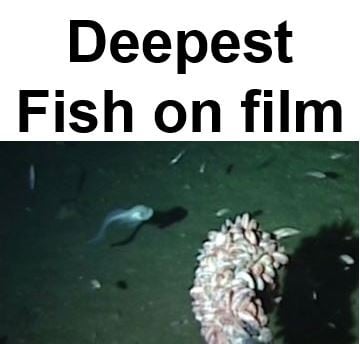In the Mariana Trench, the deepest place on Earth, a mysterious ‘supergiant’ amphipod was filmed alive for the first time, five miles underwater by an international team of microbiologists, geneticists, geologists and biologists.
University of Aberdeen scientists set a new record when they filmed the world’s deepest fish using the Hadal-Lander, a diving vehicle designed and built entirely in Aberdeenshire, Scotland.
According to a press release by the University of Aberdeen, their team has just returned from the first detailed study of the Mariana Trench aboard the Falkor, the Schmidt Ocean Institute’s Research vessel.
The team deployed deep-sampling equipment in ninety-two areas across the entire depth range (5,000 – 10,600 meters) of the trench.
This video footage, taken by scientists from Oceanlab at a dept of 8,145 meters, depicts a type of snailfish. This is a new depth-record for filming, beating the same team’s 2008 record by almost 500 meters.
The scientists had previously discovered a new species of snailfish living between 6,000 and 8,000 meters underwater. However, what surprised them this time was an elusive and extremely fragile second species.
Dr Alan Jamieson from the University of Aberdeen said:
“This really deep fish did not look like anything we had seen before, nor does it look like anything we know of. It is unbelievably fragile, with large wing-like fins and a head resembling a cartoon dog.”
The team found several other species, including an extremely rare ‘supergiant’ amphipod, a massive crustacean that was recovered by traps off New Zealand two years ago.
The video shows the giant creatures feeding, swimming, and keeping off would-be predators with their huge body size and protective tail.

Photo: University of Aberdeen.
Dr Jamieson said:
“Knowing these creatures exist is one thing, but to watch them alive in their natural habitat and interacting with other species is truly amazing, we have learnt a great deal.”
The 30-day Hadal Ecosystem Studies (HADES) expedition, led by the University of Hawaii, had set out to gather and analyze data on the environments, animals, and ecological & geological processes of the deepest areas of the world’s ocean.
Unlike previous Mariana trench studies, this one sampled a broad spectrum of environments.
Dr. Jeff Drazen, co-chief scientist from Hawaii, said:
“Many studies have rushed to the bottom of the trench but from an ecological view that is very limiting. It’s like trying to understand a mountain ecosystem by only looking at its summit.”
105 hours of video footage
The University of Aberdeen arm of the expedition says the whole event has been a major success. It was their 14th expedition to the deep trenches, where they managed to amass 105 hours of video footage, the greatest volume ever taken at these depths.
The Hadal-Lander successfully reached the bottom of the Sirena deep at 10,545 meters, making it the UK’s deepest-diving vehicle.
Wendy Schmidt, co-founder of the Schmidt Ocean Institute, said:
“Rarely, do we get a full perspective of the ocean’s unique deep environments. The questions that the scientists will be able to answer following this cruise will pave the way for a better understanding of the deep sea, which is not exempt from human impact.”
